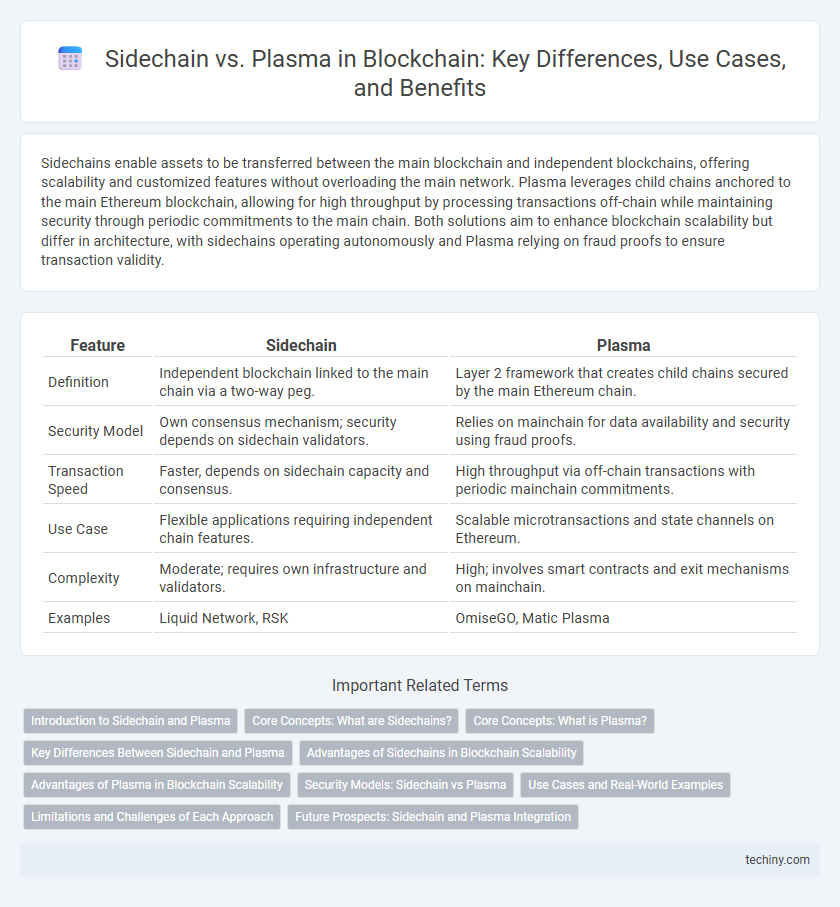Sidechains enable assets to be transferred between the main blockchain and independent blockchains, offering scalability and customized features without overloading the main network. Plasma leverages child chains anchored to the main Ethereum blockchain, allowing for high throughput by processing transactions off-chain while maintaining security through periodic commitments to the main chain. Both solutions aim to enhance blockchain scalability but differ in architecture, with sidechains operating autonomously and Plasma relying on fraud proofs to ensure transaction validity.
Table of Comparison
| Feature | Sidechain | Plasma |
|---|---|---|
| Definition | Independent blockchain linked to the main chain via a two-way peg. | Layer 2 framework that creates child chains secured by the main Ethereum chain. |
| Security Model | Own consensus mechanism; security depends on sidechain validators. | Relies on mainchain for data availability and security using fraud proofs. |
| Transaction Speed | Faster, depends on sidechain capacity and consensus. | High throughput via off-chain transactions with periodic mainchain commitments. |
| Use Case | Flexible applications requiring independent chain features. | Scalable microtransactions and state channels on Ethereum. |
| Complexity | Moderate; requires own infrastructure and validators. | High; involves smart contracts and exit mechanisms on mainchain. |
| Examples | Liquid Network, RSK | OmiseGO, Matic Plasma |
Introduction to Sidechain and Plasma
Sidechains are independent blockchains linked to a main chain, enabling asset transfers and interoperability while maintaining security and scalability. Plasma is a Layer 2 scaling solution that creates smaller child chains anchored to the Ethereum mainnet, allowing faster transactions and reduced fees. Both technologies address blockchain scalability but differ in architecture and use cases, with sidechains supporting diverse protocols and Plasma focusing on secure, off-chain computations.
Core Concepts: What are Sidechains?
Sidechains are independent blockchains attached to a parent blockchain, enabling assets and data to move securely between chains while maintaining their respective consensus rules. They facilitate scalability and interoperability by offloading transactions from the main chain, reducing congestion and enhancing performance. By using two-way pegs, sidechains ensure asset transfers remain secure and verifiable across different blockchain environments.
Core Concepts: What is Plasma?
Plasma is a Layer 2 scaling solution that enables the creation of smaller, child blockchains (sidechains) anchored to the main Ethereum blockchain, allowing for faster and more cost-effective transactions. It uses a hierarchical structure where each Plasma chain can process numerous transactions off-chain and periodically submit proofs to the main chain to ensure security and finality. Unlike general sidechains, Plasma emphasizes security through fraud proofs and exit mechanisms, enabling users to challenge invalid state transitions and safely withdraw their assets.
Key Differences Between Sidechain and Plasma
Sidechains operate as independent blockchains linked to the main chain, enabling asset transfers and enhanced scalability with distinct consensus mechanisms. Plasma constructs smaller child chains optimized for specific transaction types, relying on the main Ethereum chain for security and dispute resolution through fraud proofs. The primary difference lies in security: sidechains maintain separate security models, while Plasma inherits security from the parent chain, offering greater trust but potentially limited flexibility.
Advantages of Sidechains in Blockchain Scalability
Sidechains enhance blockchain scalability by enabling the transfer of assets between the main chain and the sidechain without congesting the primary network, allowing for increased transaction throughput and faster processing times. They offer greater flexibility for developers to experiment with new features and consensus mechanisms independently of the main blockchain, reducing risks and improving security. This separation of networks also facilitates interoperability between different blockchain platforms, broadening the use cases and adoption of decentralized applications.
Advantages of Plasma in Blockchain Scalability
Plasma enhances blockchain scalability by enabling the creation of smaller, child blockchains that process transactions off the main chain, significantly reducing on-chain congestion. It offers improved security through periodic commitments to the root chain, ensuring data integrity without sacrificing decentralization. The hierarchical structure of Plasma supports efficient handling of high transaction volumes while maintaining trustlessness and minimizing network fees.
Security Models: Sidechain vs Plasma
Sidechain and Plasma differ significantly in their security models; sidechains operate as independent blockchains with their own consensus mechanisms, requiring trust in the sidechain validators to maintain security. Plasma relies on the security of the main Ethereum chain by committing periodic proofs or fraud proofs to the root chain, allowing users to challenge invalid transactions and exit malicious chains. The choice between sidechain and Plasma security hinges on whether an application prioritizes decentralized validation autonomy or the security guarantees inherited from the mainnet.
Use Cases and Real-World Examples
Sidechains enable independent blockchains to interact with a main chain, supporting use cases like asset transfers and gaming by allowing customized consensus mechanisms, exemplified by Liquid Network's Bitcoin sidechain for faster transactions. Plasma facilitates scalable decentralized applications on Ethereum by batching transactions off-chain and settling final states on-chain, ideal for micropayments and gaming, as demonstrated by OMG Network's implementation. Both solutions address scalability but differ in architecture and specific use cases, with sidechains offering broader flexibility and Plasma focusing on high-throughput, low-cost Ethereum-based apps.
Limitations and Challenges of Each Approach
Sidechains face limitations such as security risks due to their reliance on a separate consensus mechanism, which can lead to vulnerabilities distinct from the main blockchain. Plasma struggles with scalability issues caused by complex exit procedures and potential bottlenecks in transaction finality, impacting user experience. Both approaches challenge interoperability and require robust mechanisms to prevent fraud and maintain asset security across networks.
Future Prospects: Sidechain and Plasma Integration
Sidechain and Plasma integration promises enhanced scalability and security for blockchain networks by enabling off-chain transaction processing with strong guarantees. This fusion can support complex decentralized applications through interoperable sidechains that leverage Plasma's efficient fraud-proof mechanisms. Future developments focus on combining sidechain flexibility with Plasma's robust dispute resolution to facilitate faster, cost-effective blockchain ecosystems.
Sidechain vs Plasma Infographic

 techiny.com
techiny.com